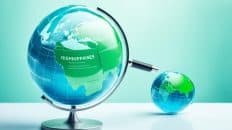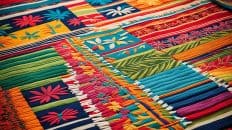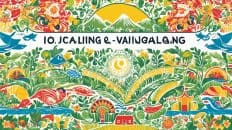Tagalog, also known as Wikang Tagalog, is an Austronesian language spoken in the Philippines. With approximately 29 million native speakers and a total of 83 million speakers, Tagalog is one of the major languages in the country. It is primarily spoken in the Katagalugan region, which includes Metro Manila and parts of Central Luzon, Calabarzon, and Mimaropa. Tagalog is the basis for the national language of the Philippines, Filipino, and is recognized as a regional language in predominantly Tagalog-speaking areas.
Tagalog is part of the Malayo-Polynesian language family and has various dialects, including Bataan, Batangas, Bulacan, Lubang, Manila, Marinduque, Puray, Tanay-Paete, and Tayabas. Its writing system uses the Filipino alphabet, Latin script, and historically, the Baybayin script. Whether you’re interested in learning Tagalog for travel, personal growth, or connecting with the vibrant Filipino culture, there are various resources and courses available to help you on your language journey.
Key Takeaways:
- Tagalog is an Austronesian language spoken in the Philippines, primarily in the Katagalugan region.
- It is the basis for the national language of the Philippines, Filipino.
- Tagalog is part of the Malayo-Polynesian language family and has various dialects.
- Learning Tagalog can open doors to the vibrant Filipino culture and enhance communication with Tagalog speakers.
- There are resources and courses available online to support your Tagalog language learning journey.
Classification of Tagalog
Tagalog is a Northern Philippine language classified within the Austronesian language family. It is closely related to several other Philippine languages, such as the Bikol languages, Bisayan languages, Ilocano, Kapampangan, and Pangasinan. As a member of the Austronesian family, Tagalog also shares similarities with other languages, including the Formosan languages of Taiwan, Indonesian, Malay, Hawaiian, Māori, and Malagasy. Within the Malayo-Polynesian branch of the Austronesian family, Tagalog is categorized alongside languages like Malagasy, Javanese, Tetum, and Yami.
Understanding the classification of Tagalog provides insights into its linguistic connections and the broader context of Philippine and Austronesian languages.
Note: Tagalog’s classification within the Austronesian language family
Historical Background of Tagalog
The history of Tagalog is deeply rooted in ancient times, with evidence of Old Tagalog words found in the Laguna Copperplate Inscription from the 10th century. This ancient artifact provides a glimpse into the early roots of the Tagalog language and its development over time.
A significant milestone in the history of Tagalog is the publication of the Doctrina Christiana in 1593. This book, written in Tagalog, marked the first known complete work in the language. It played a crucial role in the dissemination of Christianity and the spread of Tagalog literacy during the Spanish colonial period.
Spanish clergymen also made significant contributions to the study and preservation of Tagalog. Grammars, dictionaries, and books were written by Spanish missionaries, aiding in the understanding and documentation of the language. Notable works include the Vocabulario de la lengua tagala by Pedro de San Buenaventura and the comprehensive dictionary compiled by Francisco Jansens, José Hernandez, Juan de Noceda, and Pedro de Sanlucar.
The works of renowned poet Francisco Balagtas, particularly his masterpiece Florante at Laura, further shaped Tagalog literature and showcased the beauty of the language. This literary tradition continues to thrive, reflecting the cultural richness of the Tagalog-speaking community.
Throughout its history, Tagalog has undergone changes influenced by various languages, including Spanish, English, and other Philippine languages. These influences have shaped the vocabulary, grammar, and pronunciation of Tagalog, making it a dynamic and evolving language.
Notable Works of Tagalog Literature:
“Florante at Laura” by Francisco Balagtas
Contributions by Spanish Missionaries:
- Vocabulario de la lengua tagala by Pedro de San Buenaventura
- Dictionario Hispanico-Tagalog by Francisco Jansens, José Hernandez, Juan de Noceda, and Pedro de Sanlucar
Influence and Evolution of Tagalog:
Tagalog has been influenced by Spanish, English, and other Philippine languages, resulting in a language that is both unique and diverse.
Official Status of Tagalog
In the Philippines, Tagalog holds the prestigious status of being the official language of the country. It is universally recognized as Filipino, the national language of the Philippines. Additionally, Tagalog has gained recognition as an official language in the Association of Southeast Asian Nations (ASEAN). The regulation and development of Tagalog and Filipino are overseen by the Komisyon sa Wikang Filipino, the governing body responsible for managing and promoting the Filipino language.
While Tagalog is the official language, it also serves as a regional language and an auxiliary official language in predominantly Tagalog-speaking areas. This recognition highlights the language’s cultural and linguistic significance within certain regions of the Philippines. The use of Tagalog in these areas contributes to the preservation and promotion of the rich linguistic diversity found in the country.
The status and naming of the language have evolved over time. Originally referred to as Tagalog, it later became known as Pilipino before eventually being standardized as Filipino. These changes reflect the dynamic nature of language and the efforts to accommodate the evolving linguistic landscape of the nation.
Tagalog Language Education
Tagalog language instruction is easily accessible through various educational institutions and programs. One notable institution that offers Tagalog courses is the Department of Asian Studies at Cornell University. They provide comprehensive language instruction at different proficiency levels, catering to beginners, intermediate learners, and advanced speakers.
These courses are designed to develop essential skills in speaking, listening, reading, and writing Tagalog. Students can expect a well-rounded language learning experience that equips them with the confidence to communicate effectively in Tagalog.
For those with specific language learning needs, specialized studies and directed courses can be arranged to address individual requirements. This personalized approach ensures that learners can focus on specific aspects of the language that are relevant to their goals.
In addition to these instructional programs, there are also heritage language programs aimed at individuals of Filipino descent. These programs play a crucial role in preserving and promoting the cultural heritage and linguistic diversity of the Tagalog-speaking community.
By participating in heritage language programs, individuals can maintain and develop their Tagalog language skills while deepening their connection to their Filipino roots. These programs provide a supportive environment where learners can engage with their heritage language, fostering a sense of cultural identity and pride.
Whether through institutional language instruction or heritage language programs, the availability of Tagalog language education empowers individuals to embrace and explore the richness of the Tagalog language and its cultural significance.
Tagalog Language Resources Online
When it comes to learning and exploring the Tagalog language, there are plenty of online resources available. Whether you’re a beginner or an advanced learner, these websites can provide valuable insights into the grammar, vocabulary, and usage of Tagalog.
One such resource is Ethnologue, a comprehensive website that offers in-depth information and profiles about Tagalog. It covers various aspects of the language, including its classification, dialects, and linguistic features.
Omniglot is another useful website for Tagalog learners. It provides a wealth of information about the Tagalog writing system, pronunciation, and basic phrases. This resource can be particularly helpful for beginners looking to get started with the language.
If you’re in need of a reliable Tagalog dictionary, Tagalog website has got you covered. It offers an extensive collection of Tagalog dictionaries and translators, allowing you to easily translate and understand Tagalog words and phrases.
For those looking for more structured learning resources, there are websites that offer Tagalog courses, lessons, and cultural insights. These resources cater specifically to Tagalog language learners and provide a comprehensive learning experience.
Tagalog Language Resources Online:
| Website | Description |
|---|---|
| Ethnologue | Comprehensive information and profiles about Tagalog language |
| Omniglot | Information on Tagalog writing system, pronunciation, and basic phrases |
| Tagalog | Extensive collection of Tagalog dictionaries and translators |
| Tagalog Language Learning | Tagalog courses, lessons, and cultural insights specifically for learners |
These online resources can greatly enhance your Tagalog learning journey, providing you with the tools and information needed to become proficient in this beautiful language.
Tagalog Language Speakers
Tagalog is primarily spoken by the ethnic Tagalog people, who make up a significant portion of the population in the Philippines. It is widely spoken in the Tagalog-speaking regions, including Metro Manila and parts of Central Luzon, Calabarzon, and Mimaropa.
The influence of the Tagalog language extends beyond the borders of the Philippines. Tagalog-speaking communities can be found in different parts of the world, particularly in countries with a significant Filipino diaspora. These include Canada, Saudi Arabia, United Arab Emirates, the United Kingdom, and the United States.
In fact, Tagalog has gained recognition in the United States as the sixth most spoken language, with over a million Tagalog language speakers according to the 2000 U.S. Census. The Tagalog-speaking diaspora in the United States contributes to the vibrant multicultural fabric of the country, preserving their language and cultural heritage.
Future of Tagalog
Language experts predict an intriguing future for Tagalog, speculating that it may eventually evolve and separate from Filipino to become two distinct languages. Currently considered varieties or dialects of the same language, Tagalog and Filipino could undergo significant changes due to the influence of other languages. As the Philippines embraces its linguistic diversity and continues to evolve, the evolution of Tagalog and Filipino into separate languages is a possibility.
“Language is constantly evolving, and Tagalog is no exception. As other languages contribute to Filipino, we may witness a linguistic shift that results in Tagalog and Filipino becoming separate languages in the future.”
Tagalog Language Representative
Dr. Valerie Malabonga plays a vital role as the Tagalog language representative for the Alliance for the Advancement of Heritage Languages. This organization is dedicated to promoting and supporting heritage language programs and resources, including Tagalog. As the Tagalog language representative, Dr. Malabonga actively contributes to the Alliance’s efforts in advocating for the preservation and development of Tagalog language education and resources.
Conclusion
The Tagalog language plays a crucial role in the cultural heritage and linguistic diversity of the Philippines. With its rich history, diverse dialects, and global presence, learning Tagalog opens doors to the vibrant Filipino culture and facilitates communication with Tagalog speakers. Moreover, language education and resources contribute to the preservation and development of Tagalog, further enriching the linguistic and cultural landscape of the country.
Tagalog, also known as Wikang Tagalog, is an Austronesian language spoken by millions of native speakers in the Philippines. It serves as the basis for the national language, Filipino, and is recognized as a regional language in predominantly Tagalog-speaking areas. Through the study of Tagalog, individuals gain a deeper understanding of the country’s cultural heritage and enhance their linguistic skills.
As the Philippines embraces its linguistic diversity, the future of Tagalog and Filipino presents intriguing possibilities. Language experts suggest that the inclusion of various linguistic influences may eventually lead to the separation of Tagalog and Filipino as distinct languages. This evolution highlights the ever-changing nature of languages and emphasizes the importance of language preservation and development.
In conclusion, the Tagalog language holds immense value, both in terms of cultural heritage and language learning. By engaging in Tagalog language education and utilizing available resources, individuals contribute to the wider appreciation and understanding of the Filipino identity, fostering linguistic diversity and cultural enrichment.
FAQ
What is Tagalog?
How many speakers does Tagalog have?
Tagalog has approximately 29 million native speakers and a total of 83 million speakers. It is primarily spoken in the Katagalugan region, which includes Metro Manila and parts of Central Luzon, Calabarzon, and Mimaropa.
What are the dialects of Tagalog?
What is the history of Tagalog?
The history of Tagalog dates back to ancient times, with possible Old Tagalog words found in the Laguna Copperplate Inscription from the 10th century. The first known complete book written in Tagalog is the Doctrina Christiana, published in 1593.
Is Tagalog an official language?
Yes, Tagalog is the official language of the Philippines and is recognized nationally as Filipino. It is also an official language in the Association of Southeast Asian Nations (ASEAN).
Are there resources available for learning Tagalog?
Yes, there are various online resources available for learning and exploring the Tagalog language. Websites such as Ethnologue, Omniglot, and Tagalog offer comprehensive information and profiles about Tagalog. Online dictionaries and translators can also assist in translating and understanding Tagalog words and phrases.
Where is Tagalog spoken?
Tagalog is primarily spoken in the Katagalugan region, which includes Metro Manila and parts of Central Luzon, Calabarzon, and Mimaropa. Tagalog-speaking communities can also be found outside of the Philippines, particularly in countries with a significant Filipino diaspora, such as the United States, Canada, Saudi Arabia, United Arab Emirates, and the United Kingdom.
What is the future of Tagalog?
Who is the Tagalog language representative?
Why is learning Tagalog important?
Learning Tagalog provides individuals with access to the vibrant Filipino culture and opens opportunities for communication with Tagalog speakers. It also contributes to the overall linguistic and cultural landscape of the Philippines.








Add comment